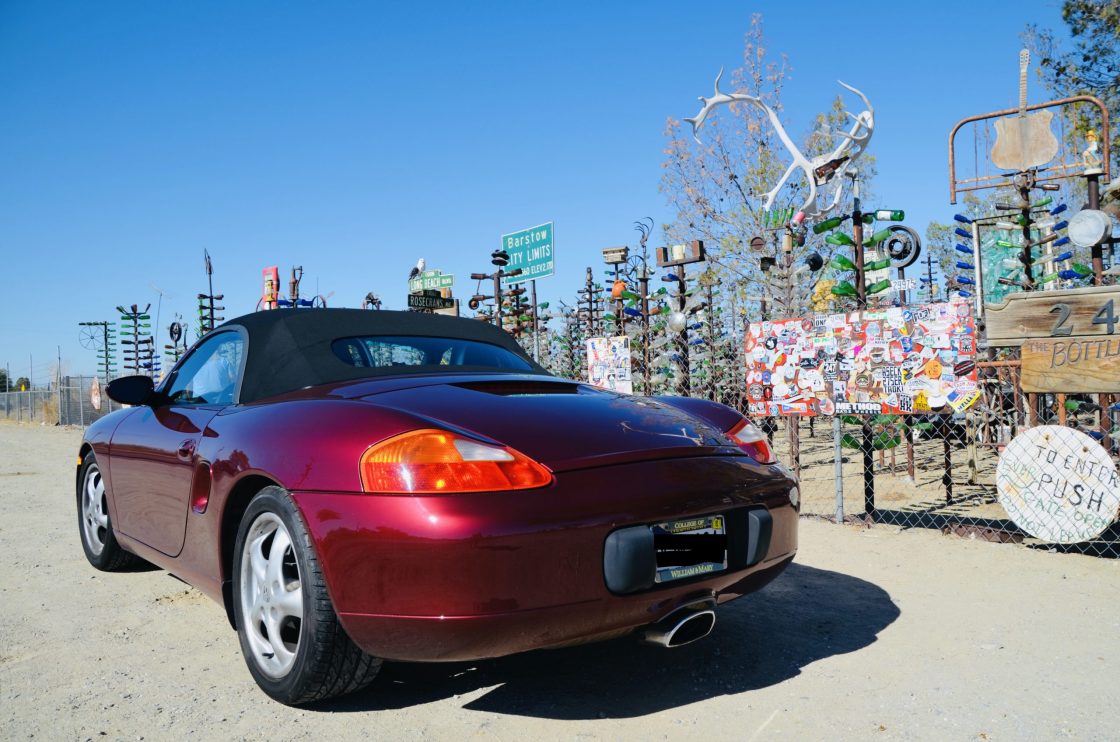Article and photos by Larry Johnson
From June 16 – 30, Holly and I completed a special journey along the famed and historic Route 66 from Springfield, Missouri, to Santa Monica Pier in California. Along the way we discovered a world of hidden and, in many instances, unexpected treasures. The following day-to-day account describes our journey across America from the heartland to the Pacific coast.
Day One: June 16. Omaha to Springfield. We began the ten-day journey at the route’s original birthplace in Missouri. We reached Springfield during the late afternoon and checked into the
Route 66 Rail Haven Motel. The motel had a definite, step-back-in-time feel to it which added to its charm. Also, according to the motel’s message board, Elvis Presley spent the night there in 1956.
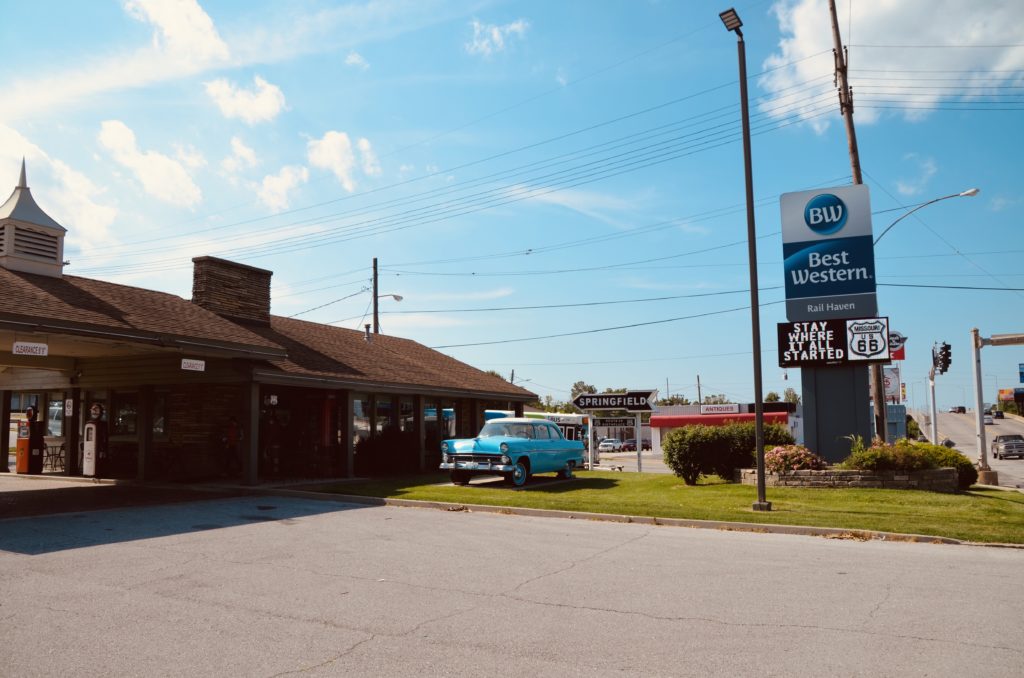
Day Two: June 17. Springfield to Tulsa, Oklahoma. Along with the goal of visiting as many as possible of Route 66’s unique landmarks, we also hoped to limit each day’s drive to a minimum number of hours. At this early point in the trip, following the brown-colored Route 66 signs was easy. Positioned approximately a mile apart, the signs decreased the possibility of getting lost.
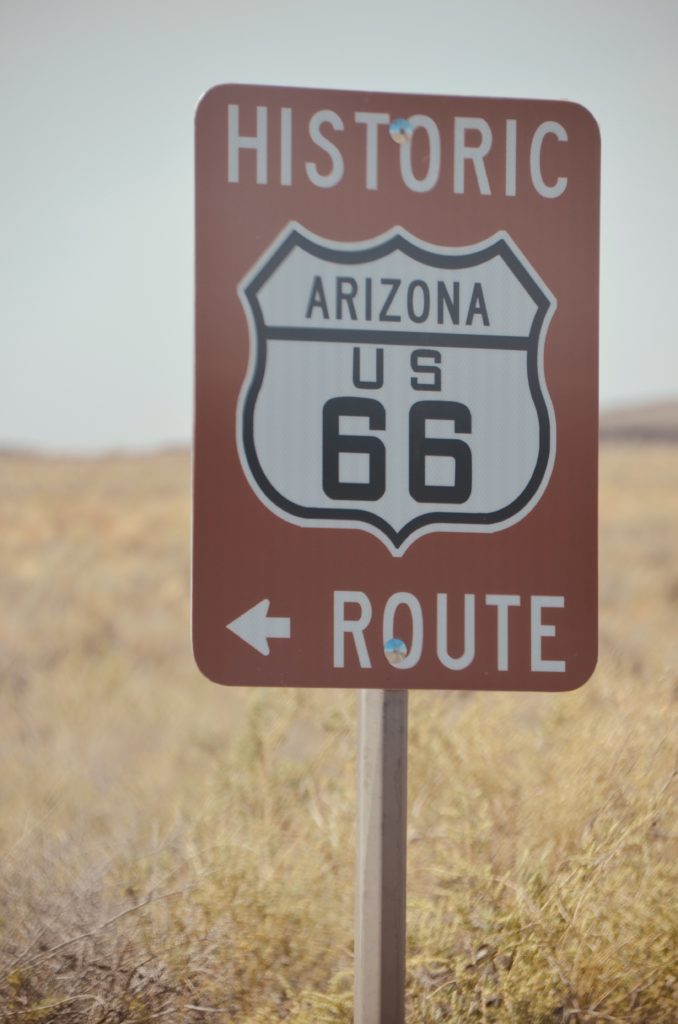
Our first day on Route 66 required approximately four hours from start to end. Just after leaving Springfield, we encountered the first of many deserted filling stations homes, store fronts, and other businesses which early Route 66 travelers depended on. This trend continued all the way to Santa Monica and in many ways, reminded us of silent ghosts representing an era gone by. Very little of Route 66 stretches through Kansas but in no way does this diminish the Sunflower State’s contribution to the Mother Road. By lunchtime, with temperatures near the high-90s and rising – a trend which continued until we reached western Nebraska on the return trip – we arrived at Nelson’s Old Riverton Store, and, taking the advice from our guidebook, stopped for handmade deli sandwiches. The warm and personal hospitality offered by the owners was greatly appreciated and convinced us our journey was off to a great start.
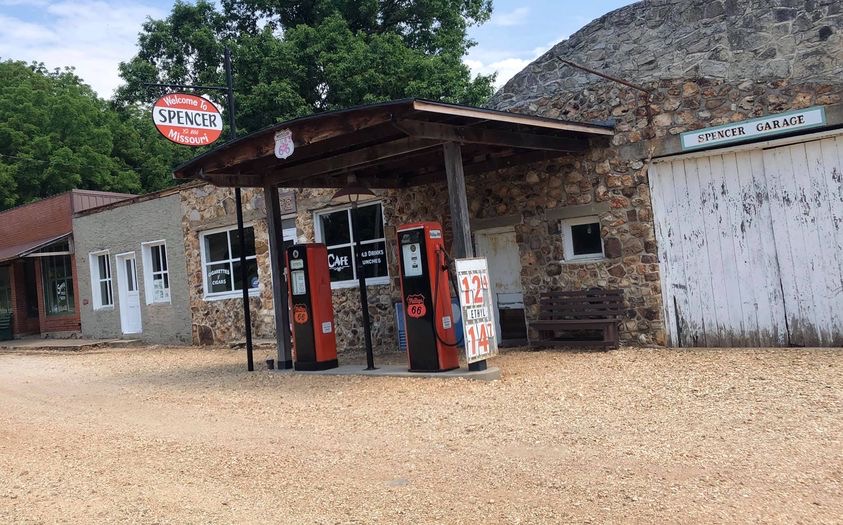
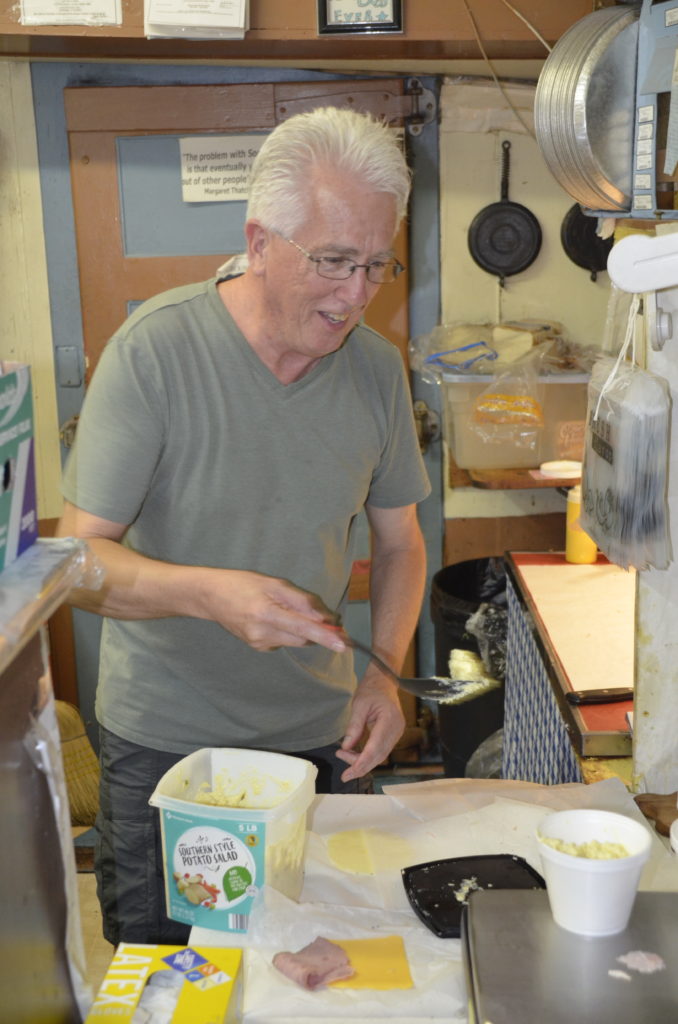
Soon after passing into Oklahoma, we encountered the infamous “Sidewalk Road.” Consisting of stretches of broken and often missing pavement, the Sidewalk Road lives up to its name by being, literally, no wider than a sidewalk. Gravel shoulders bracket the road and the three miles it stretches across the Oklahoma countryside seemed at least twice that distance. We were bounced around the interior of the car as large plumes rose up behind the car and coated the Boxster in an unwelcomed layer ash-grey dust. A word of caution if you make the trip: The Sidewalk Road is not friendly to low-lying Porsche automobiles. Think twice before taking your vehicle over this particular stretch of the Mother Road.
Back on paved and navigable roads again, we stopped at the Blue Whale near Catoosa, Oklahoma. Admission to this special, post-Route 66, manmade attraction is free and visitors are encouraged to explore the whale at their leisure. We arrived in Tulsa at the dinner hour and checked into the Campbell Hotel, a boutique-style inn erected directly on Route 66 in 1927.
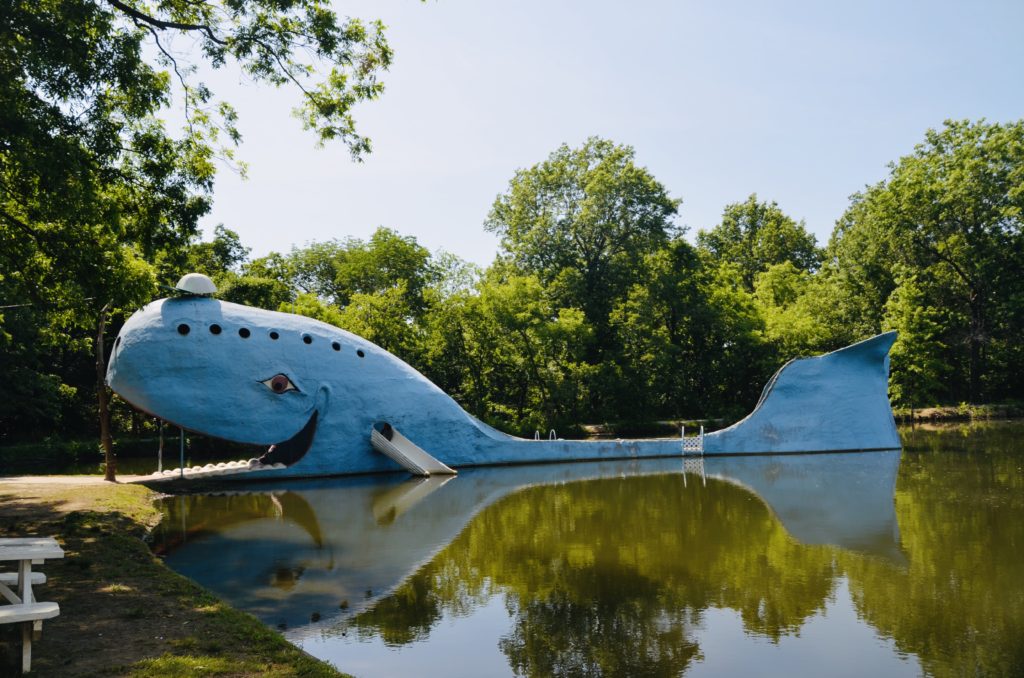
Day Three: June 18 – 19. Tulsa to Oklahoma City. A short drive on this day of approximately 100 miles. Along the way, we drove by the Skyliner Motel in Stroud, Oklahoma, and a unique, round-shaped barn in Arcadia before continuing a short distance to Pops, a welcomed stop offering cold, homemade soft drinks. Although not an original stopping point on Route 66 – the facility opened in 2007 – travelers make a point of stopping at this special attraction if only to view the many shelves of brightly colored soda bottles. It’s impossible to miss this Route 66 attraction: the 66-foot tall, LED-lit modern sculpture representing an oversized soda bottle can be seen a full quarter mile away. We arrived in Oklahoma City during the afternoon and made a point of having an early dinner at Cattleman’s Steak House which claims to offer the finest steaks in Oklahoma City. It’s been doing so since 1910. Before departing Oklahoma City, we paid our respect to the Oklahoma City National Memorial. This site is dedicated to remembering the victims of the 1995 bombing of the Alfred P. Murrah Building. Chairs representing each of the victims stand in silent tribute to the nation’s loss. On the drive out of town, we spent a few moments taking photos of the Milk Bottle Grocery, a small, 350-square foot structure featuring – you guessed it – a large, oversized milk bottle attached to the building’s roof.
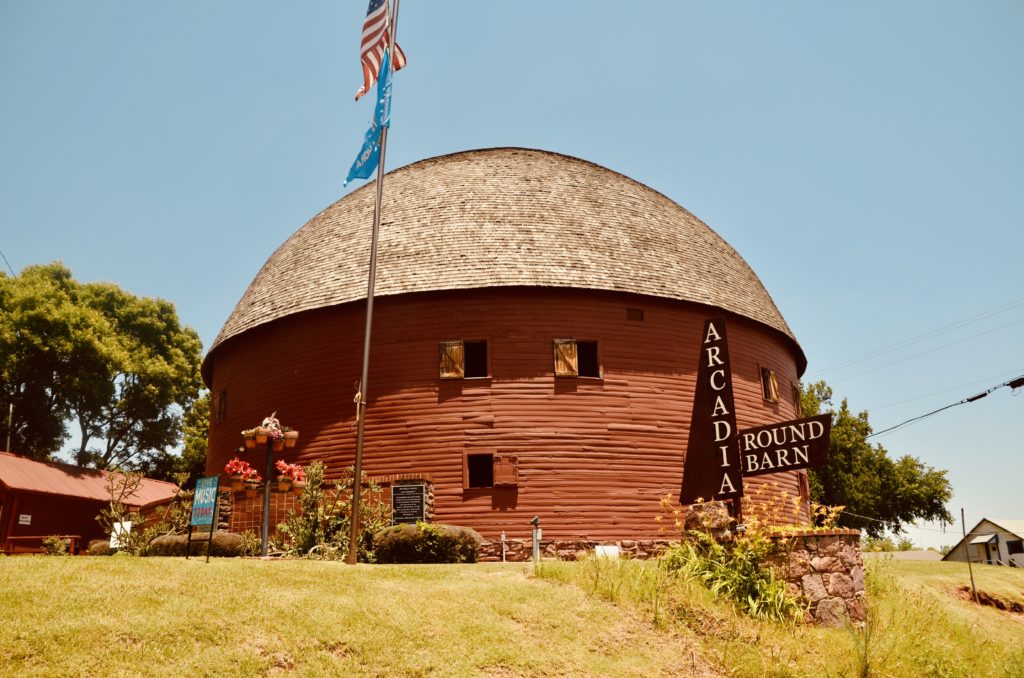
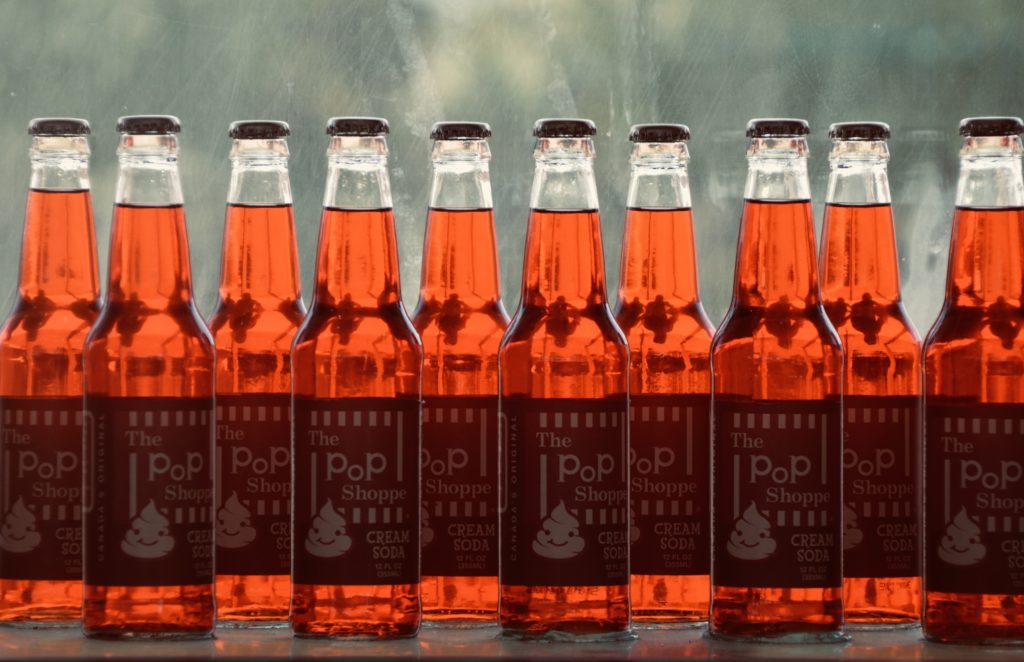
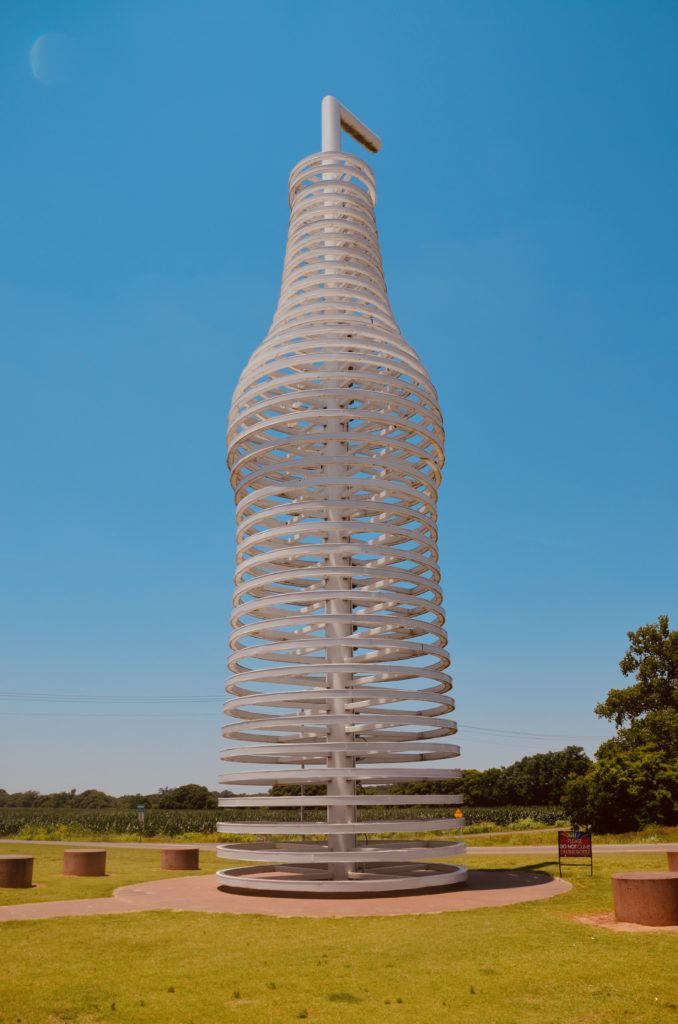
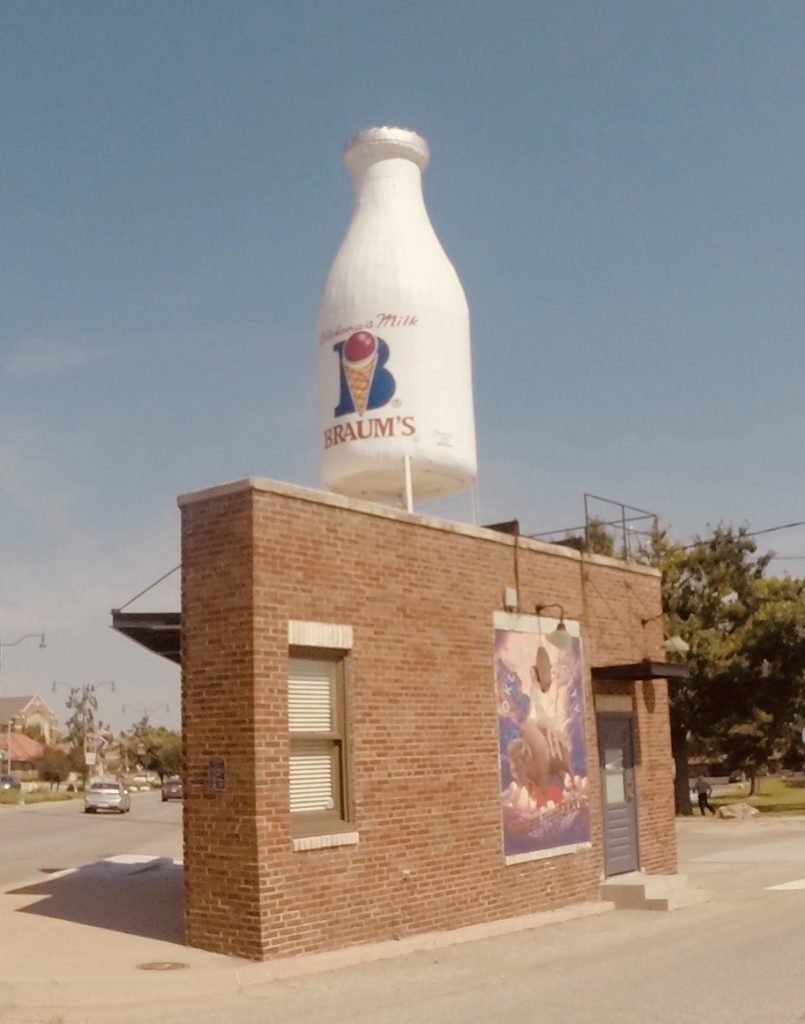
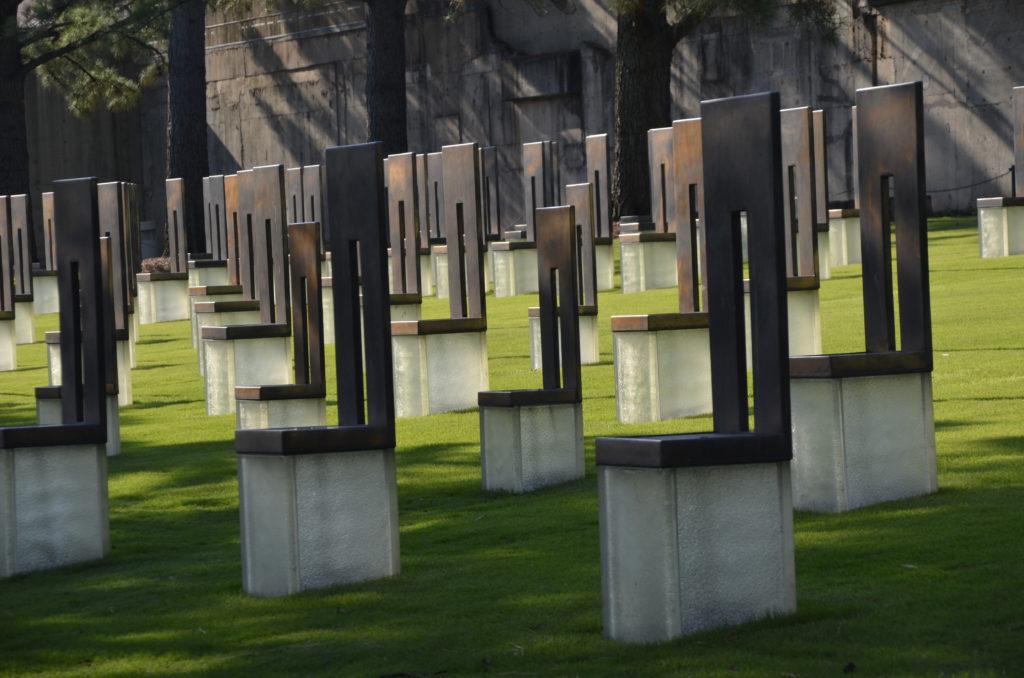
Day four: June 19. Oklahoma City to Amarillo, Texas. One of the longest days on the road and with so many miles to cover, we made the necessary decision to skirt by several attractions in order to arrive in Amarillo before nightfall. A stop in Sayre, Oklahoma, presented us with the opportunity to visit the courthouse used in the movie “The Grapes of Wrath.” Crossing into Texas, we stopped by the U-Drop Inn in Shamrock then continued on to Conway and the Slug Bug Ranch where travelers visit a collection of five, junked out, graffiti-covered Volkswagens. If you go, don’t worry about bringing your own can of spray paint: You’ll find many half-filled cans of spray paint to add your own artistic touch to the “monument.”
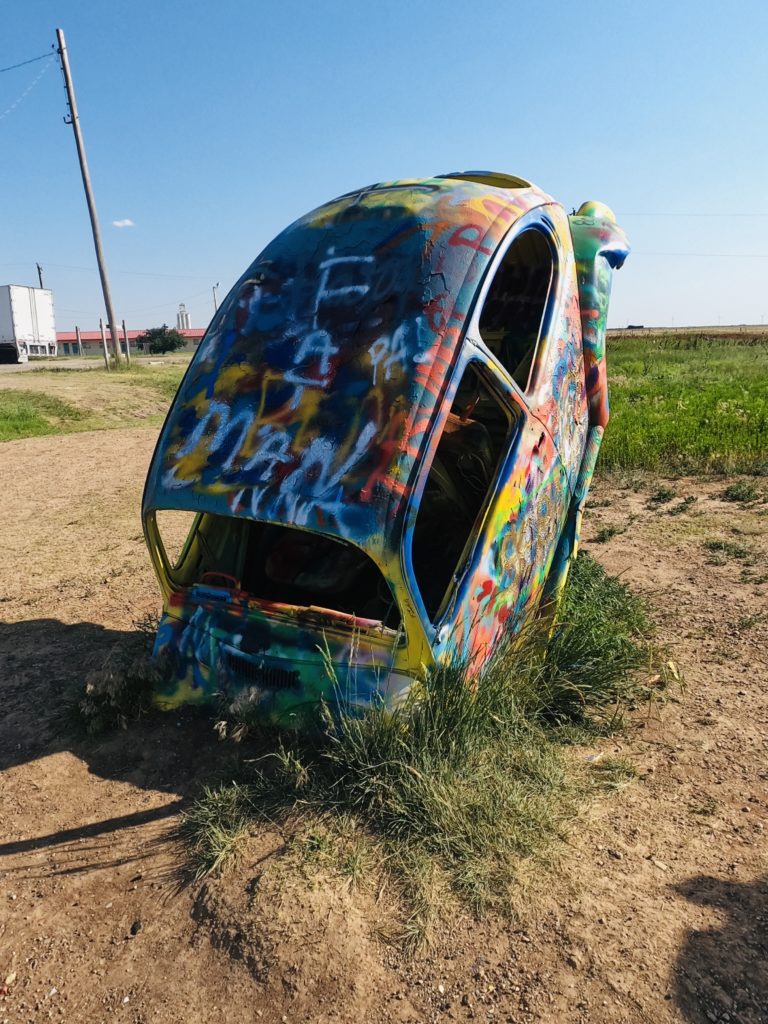
Day Five: June 20. Amarillo to Tucumcari, New Mexico. Only 115 miles to cover this day. Just outside Amarillo, we visited the Cadillac Ranch which our guidebook informed us “great art doesn’t have to live in a museum. Sometimes it exists in the middle of nowhere along the interstate.” Visitors to this attraction (also admission-free) find ten vintage Cadillacs manufactured between 1948 and 1964, buried nose-deep alongside I-40. You’ll have to detour off Route 66 to get here but it’s a short drive and well worth the trip. If you visit, you have the choice of bringing your own spray paint, or, in our case, accepting semi-filled cans from another visitor.
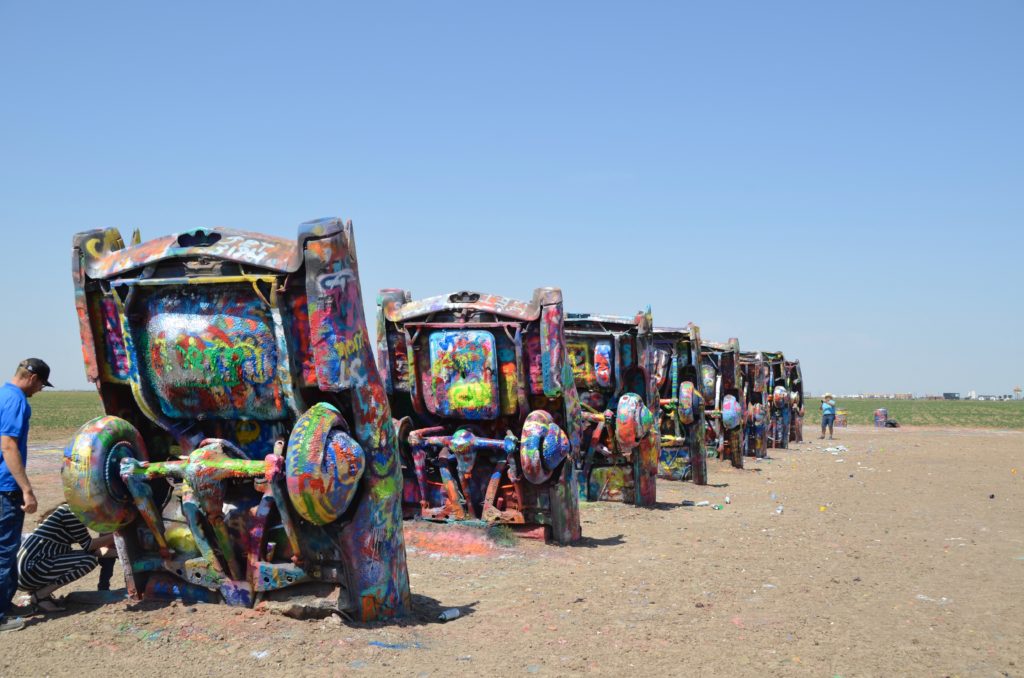
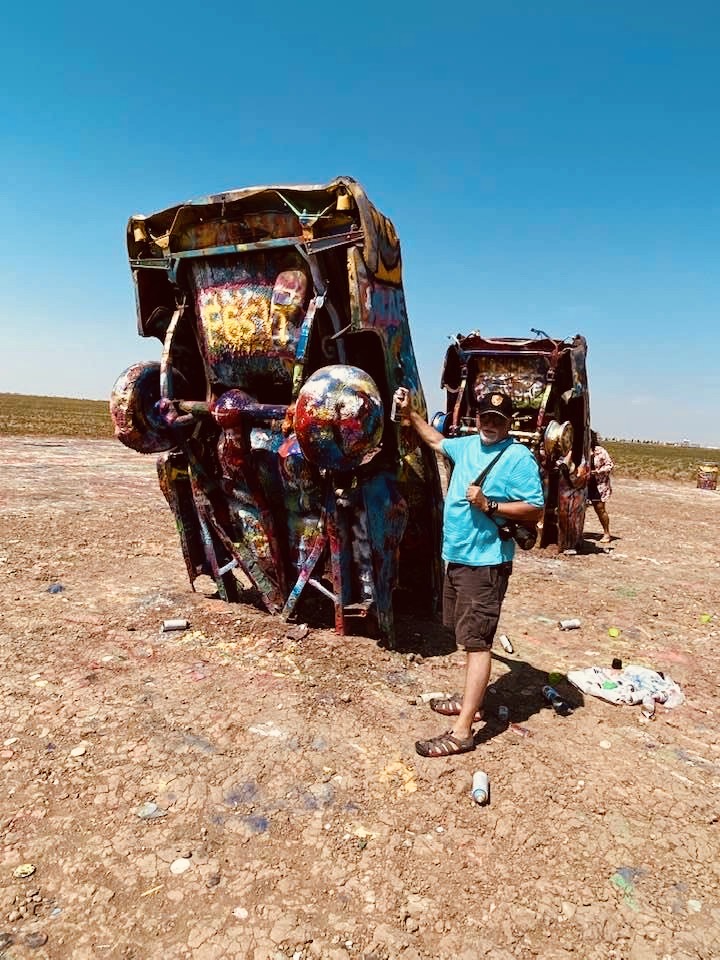
We made another off-route trip to Palo Duro Canyon, the second largest canyon in the United States. Before leaving Texas and entering New Mexico, we had to decide to lunch at Rooster’s Tex-Mex Restaurant or to press ahead to the MidPoint Café in Adrian, Texas. We chose the MidPoint Café. During Route 66’s heyday, travelers were happy to reach this point in their travels: Behind them lay 1139 miles with the same distance ahead of them. Stopping at the MidPoint Café allowed us to escape the 100 degree heat and to take a break from the road. I recommend the MidPoint Burger: It was at least the size of my head and I struggled to finish it! (I didn’t!) We arrived in Tucamcari mid-afternoon and after a short driving tour consisting of viewing murals created by local artists (mentioned in several guidebooks), we checked into the Blue Swallow Motel, a 1940s-era motel located directly on Route 66.
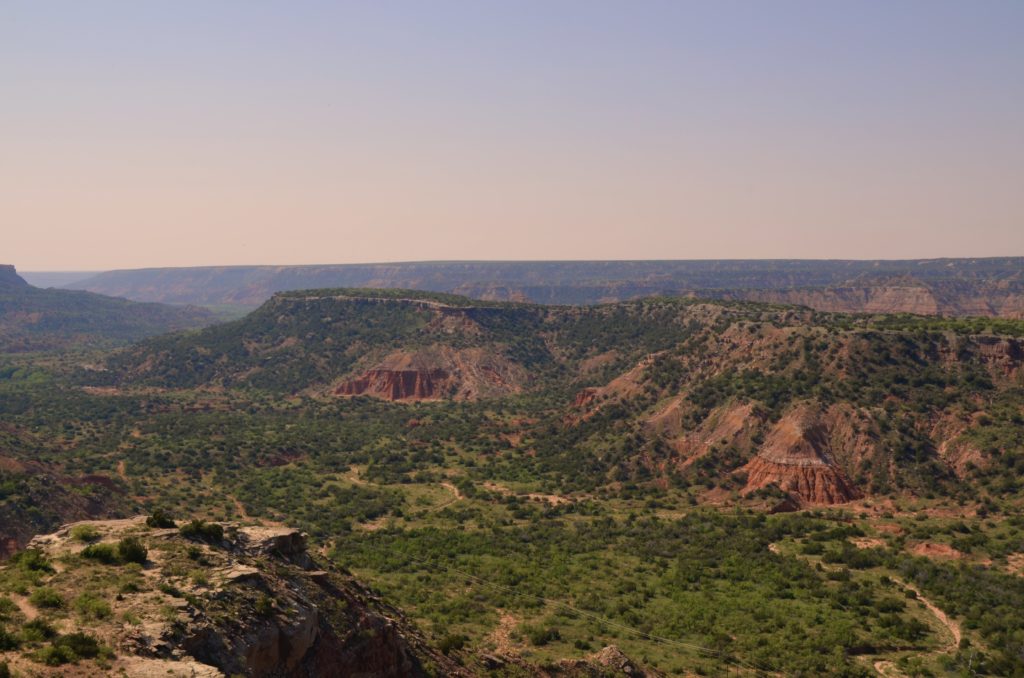
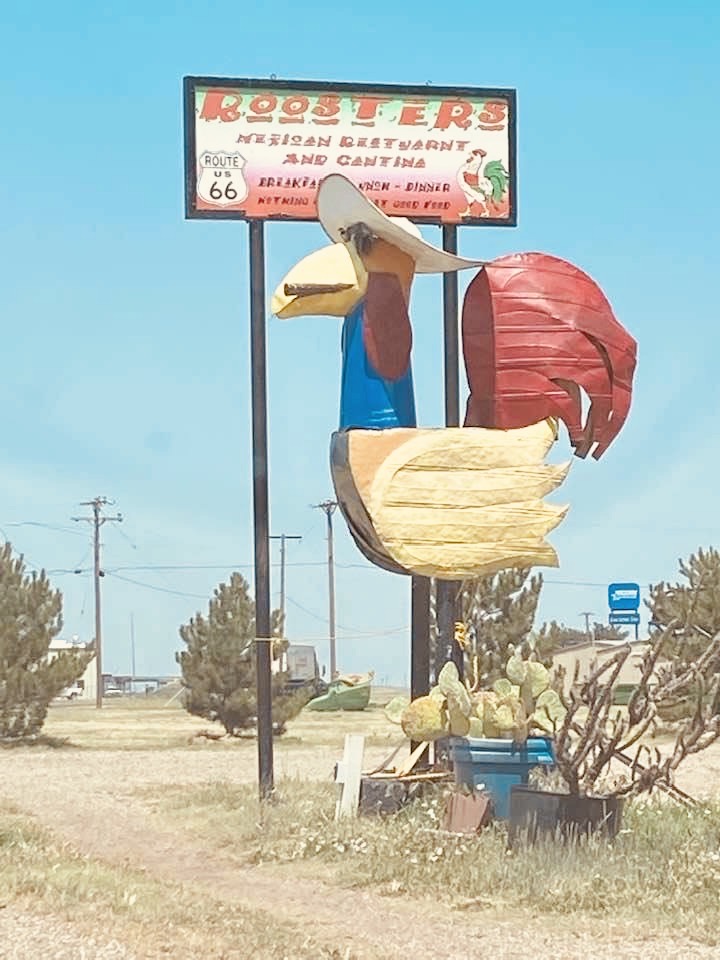
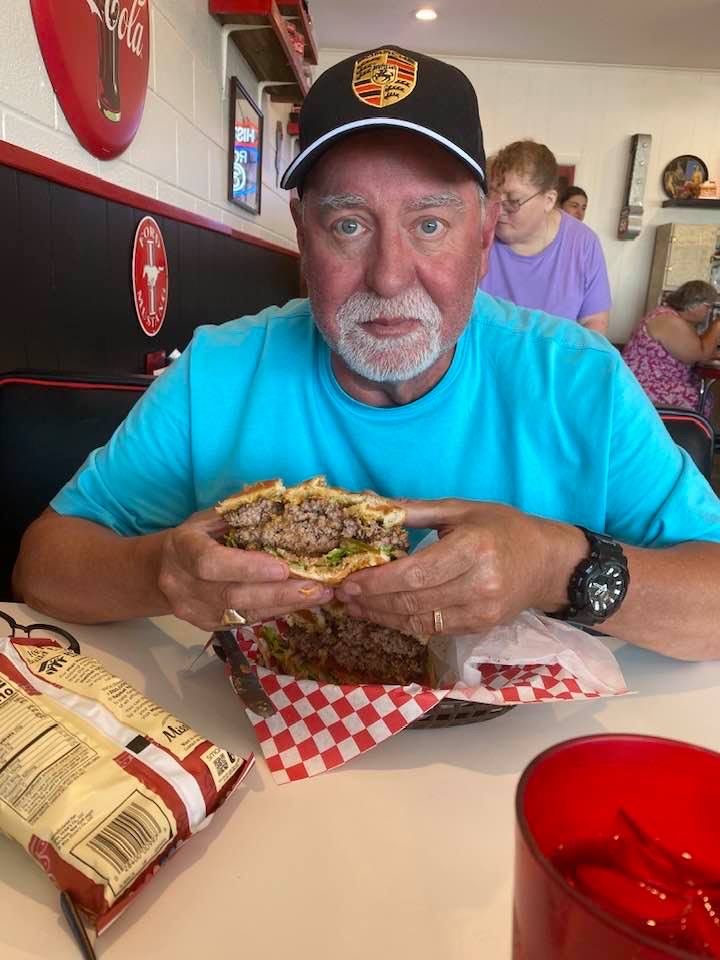
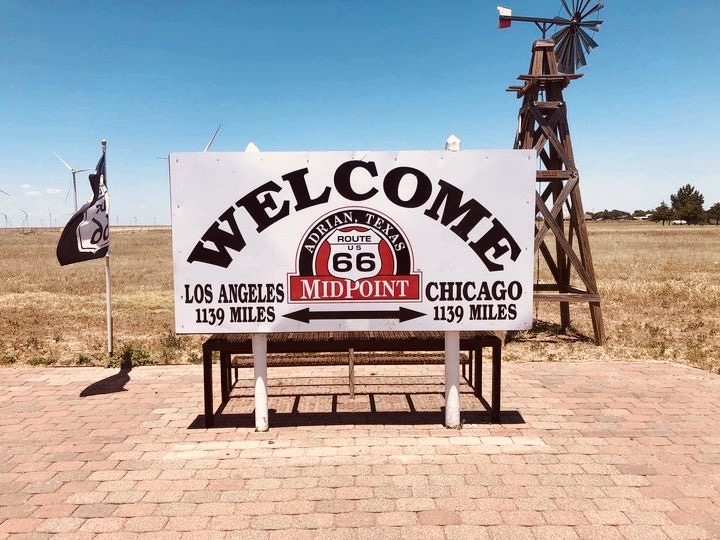
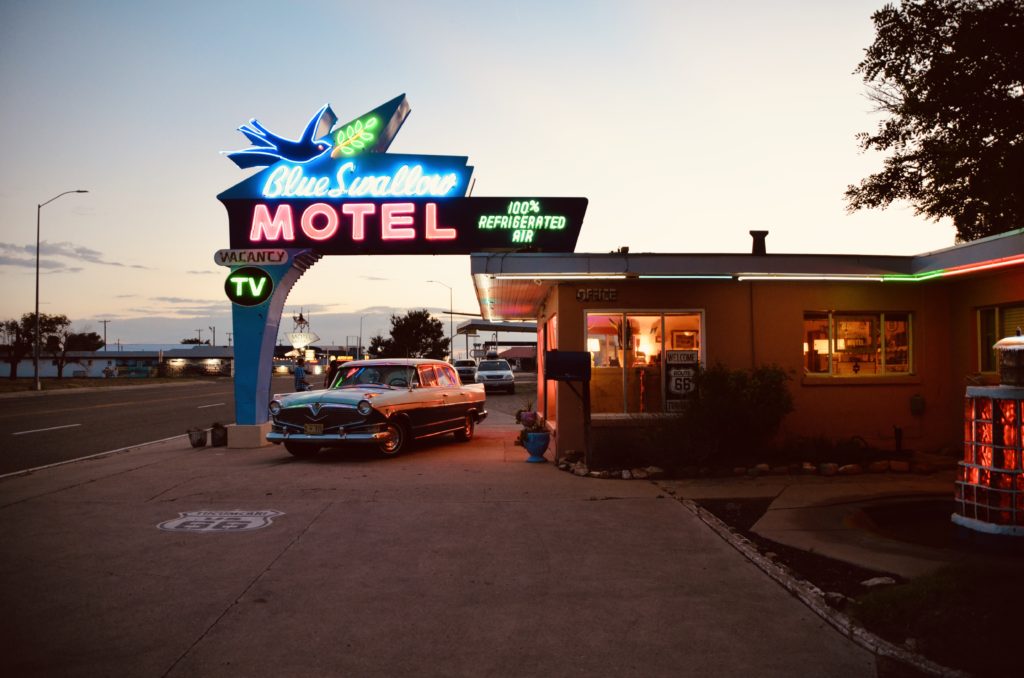
The journey along Route 66 in either direction offers travelers the unique opportunity to step back in time to multiple eras from America’s past. Of the many, many attractions found along the Mother Road, I believe the Blue Swallow and its furnishings exemplifies the heyday of Route 66’s popularity. Each room is decorated in a 1950s motif with original furnishings to include a rather large rotary dial phone. Guestrooms are equipped with one king-sized or two double beds and although the beds are, indeed, rather comfortable, they eat away at the limited amount of space available in each room. The Blue Swallow is listed on the National Register of Historic Places and owners Robert and Dawn Federico do their best to ensure every guest is treated like family.
Day Six: June 21. Tucamcari to Santa Fe, New Mexico. The sixth day of our journey required another short drive of less than 120 miles. Leaving Tucamcari in the morning, we navigated our way to Santa Rosa where we visited the Blue Hole. This naturally-formed depression features crystal clear water to a depth exceeding eighty feet and remains a crisp sixty-two degrees year round. Although Holly and I refrained from diving in, a local scuba club was preparing to enter the water. We headed south and west over fragments of the original Route 66 before passing over the Old Iron Bridge near San Jose enroute to Santa Fe. Once we arrived at the state capital, we dedicated a few moments to the city’s historic plaza before retiring for the night. For those wishing to view the works of one of America’s finest painters, Santa Fe is also the home of the Georgia O’Keefe Museum.
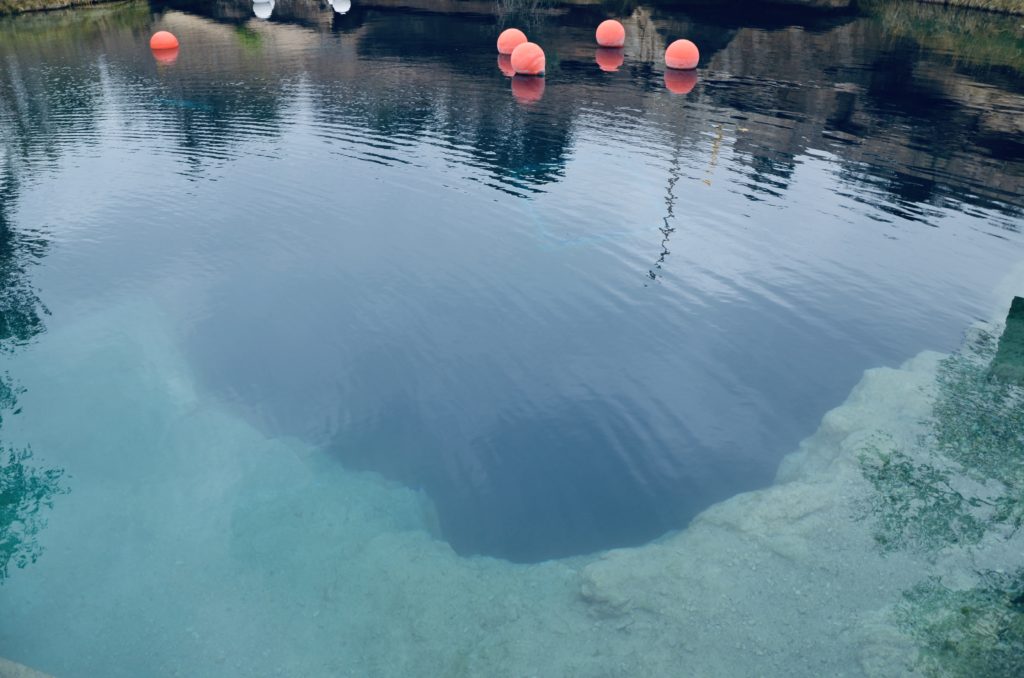
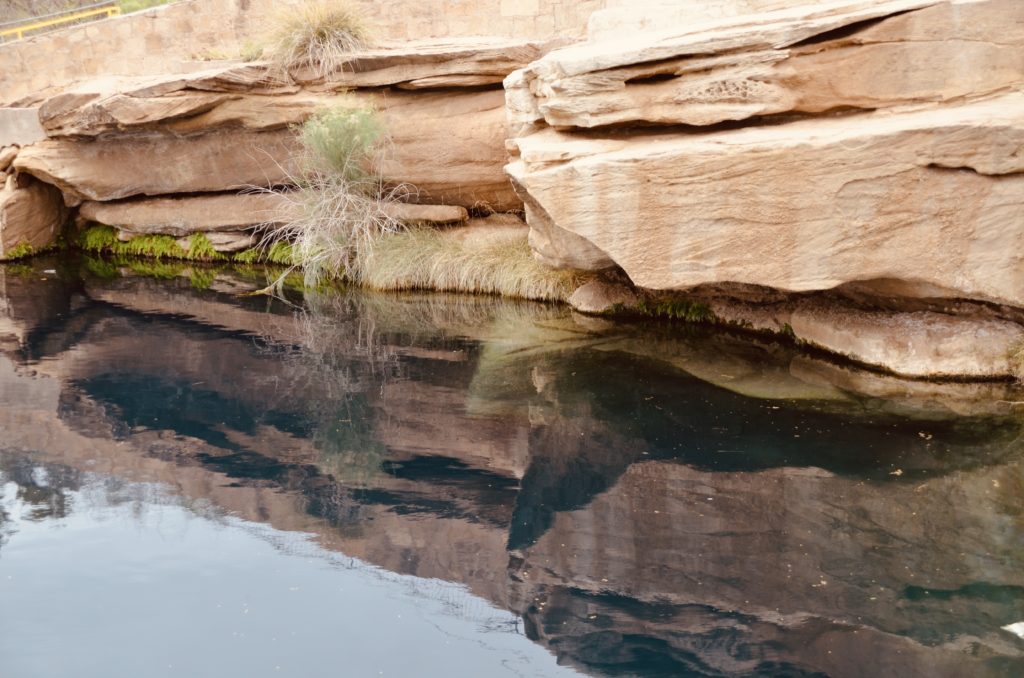
And then it happened, that one dreaded and unpredictable moment every Porsche owner fears happened approximately twenty-five miles outside Santa Fe. The Boxster’s “check engine” light illuminated to inform me something was wrong. Unsure what the cause of the alert was but with no auto repair shops in sight, I reduced speed, navigated away from Route 66 and used the interstate highway to get us to Santa Fe while keeping the vehicle at a reasonable speed. Despite planning carefully and performing preventive maintenance on the Boxster prior to our departure, I had no idea what the problem was. A quick stop at an Auto Zone and the use of a diagnostic scanner indicated the cause of the alarm was related to the catalytic converter. As soon as the clerk asked if I’d exposed the car to extremely dusty conditions within the past few days, I explained the rough travel over the Sidewalk Road. The purchase of a liquid cleaner for the catalytic converter corrected the problem and we experienced no further mechanical problems with the car. My fellow Porsche owners: That sudden sigh of relief you heard from the west was me, expressing joy over the fact I wasn’t faced with an expensive repair bill!
Day Seven: June 22. Santa Fe to Albuquerque. On most days, the drive from Santa Fe to Albuquerque requires just over an hour’s time. This, of course, is not the case if you expect to use Route 66 to get there. While we could have remained dedicated to reaching the west coast as quickly as possible by relying on multi-laned and well-paved roadways, we chose to complete the journey to Albuquerque by occasionally detouring from Route 66 and on this day, elected to make our way west via the Turquoise Trail. Receiving its name from the many turquoise mines and ghost towns located along the way, this winding road connects the high country around Santa Fe with Albuquerque. For sixty miles over narrow roads, this ancient avenue simultaneously offers pleasing vistas and the need to drive slowly. If you retrace our steps, you’ll pass through the old mining towns of Tinkertown and Madrid before connecting with Interstate 40 and the route into Albuquerque. Once in Albuquerque, we passed by the Kimo Theatre which opened one year after the birth of Route 66. Erected to feature stage productions and musicals, the Kimo was the first theatre in New Mexico to fuse art deco with American Indian architectural style. Destroyed by fire in 1968, the theatre was resurrected during the 1990s and today is home to concerts and festivals featuring classic movies. Venturing twenty miles off Route 66, we spent the night at the Los Poblanos Historic Inn and Organic Farm. After battling temperatures reaching as high as 112 degrees, it was a relief to dine and sleep in air-conditioned comfort.
Day Eight: June 23. Albuquerque to Winslow, Arizona. Before leaving New Mexico, we made time to stop by the Acoma Pueblo in Laguna, the Rio Puerco Bridge and Devil’s Cliff while navigating the vehicle through ancient lava beds. We ascended to an altitude of 7,263 feet and crossed the Continental Divide outside Thoreau, New Mexico. Arriving in Gallup near midday, we detoured two blocks off Route 66 and lunched at Jerry’s Café recommended in each of our guidebooks and a must stop location for anyone traveling along the Mother Road.
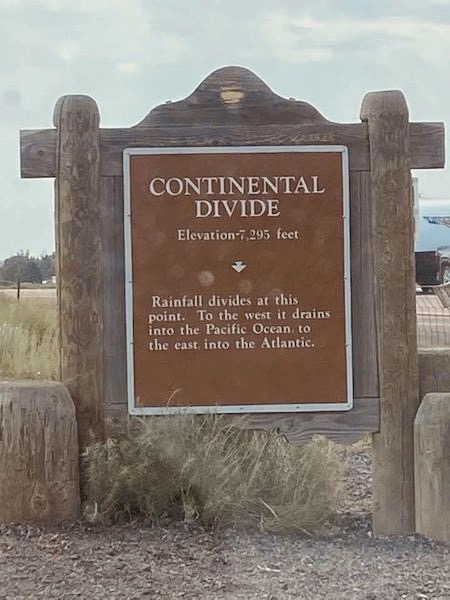
Along the route from Chicago to Santa Monica, there are many instances where Route 66 and a major highway share the same space. This was the case as we passed into Arizona near mid-afternoon. Traveling on Interstate 40, we diverted off Route 66 again and drove to the Painted Desert and Petrified Forest National Park near Navajo, Arizona. This special attraction is the only national park in the United States to protect and encompass an original section of Route 66. Visitors wind their way along a 28-mile, two-lane loop maintained by the National Park Service and are presented with mile after mile of amazing views. The northern section of the park includes the Painted Desert offering views of multi-layered strata, deep canyons, and badlands. Visitors to the park will find the petrified forest in the southern sector along with historic structures, archaeological sites, and fossil beds dating back more than 200 million years. Also located in the park is a rusted 1932 Studebaker found on an historic section of Route 66. Soon after leaving the Painted Desert, we returned to Route 66 through Holbrook, Arizona, where we found ourselves at one of only three existing Wigwam Motels still in operation in the United States. Built as part of a chain during the 1930s, the motel in Holbrook is located directly on Route 66 and for those who wish to spend the night, yes, you are afforded the opportunity to sleep in a tepee-shaped room. To add to the historic charm of Route 66, several 1950s-era autos are parked on the property. By late afternoon, we pulled into Winslow for a one-night stay at La Posada Hotel and Gardens where we spent the night in the Shirley Temple Room, directly across the hall from the Ava Gardner Suite.
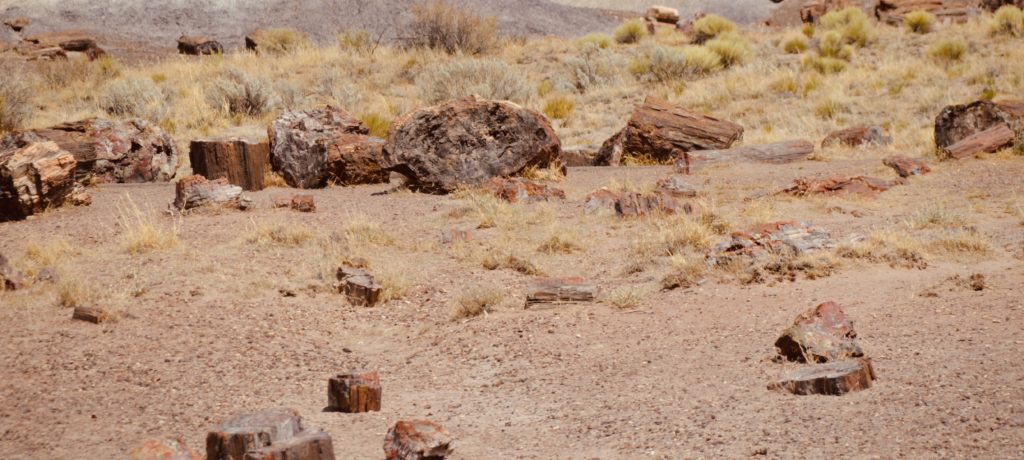
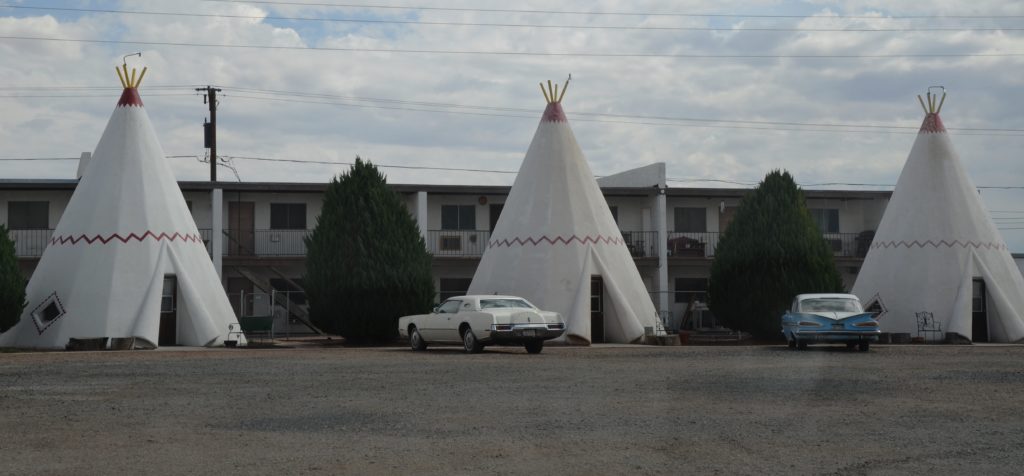
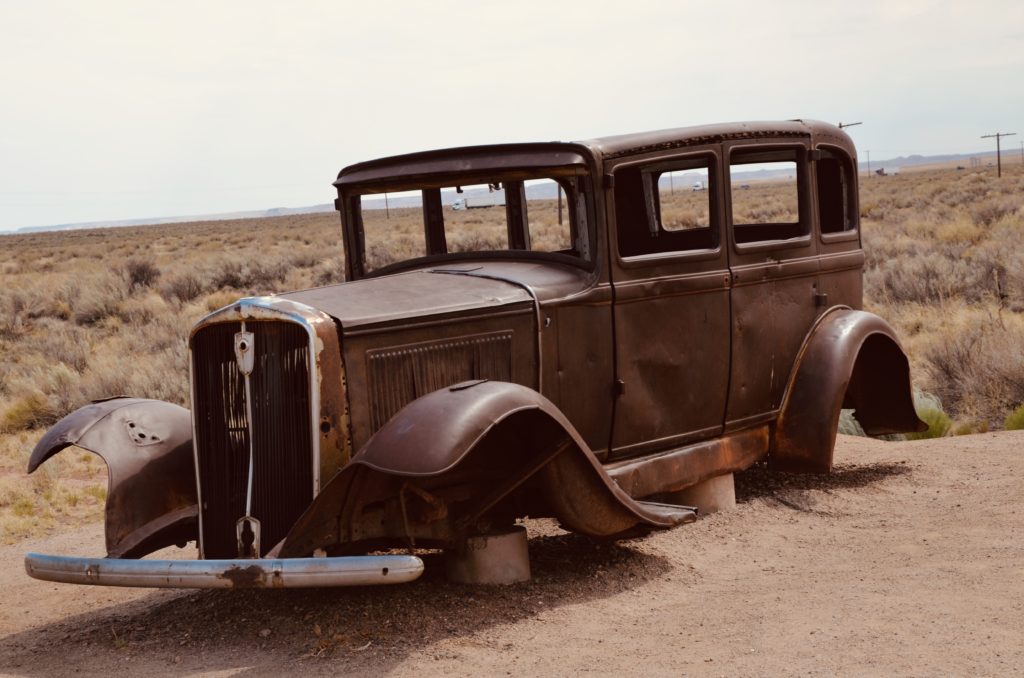
Yes, it was THAT Winslow. Anyone who has been a fan of the band The Eagles is well-aware of the significance of Winslow, Arizona, and the small town’s mention in one of rock and roll’s most famous songs. No Route 66 traveler can resist the urge to visit the “Standin’ On The Corner” Park in downtown Winslow and Holly and I were no exception. The corner features a flat-board Ford as well as statues of Eagles bandmember Glen Frey and Jackson Brown. Despite visiting the site after sunset, we found the location filled with tourists from every corner of the globe.
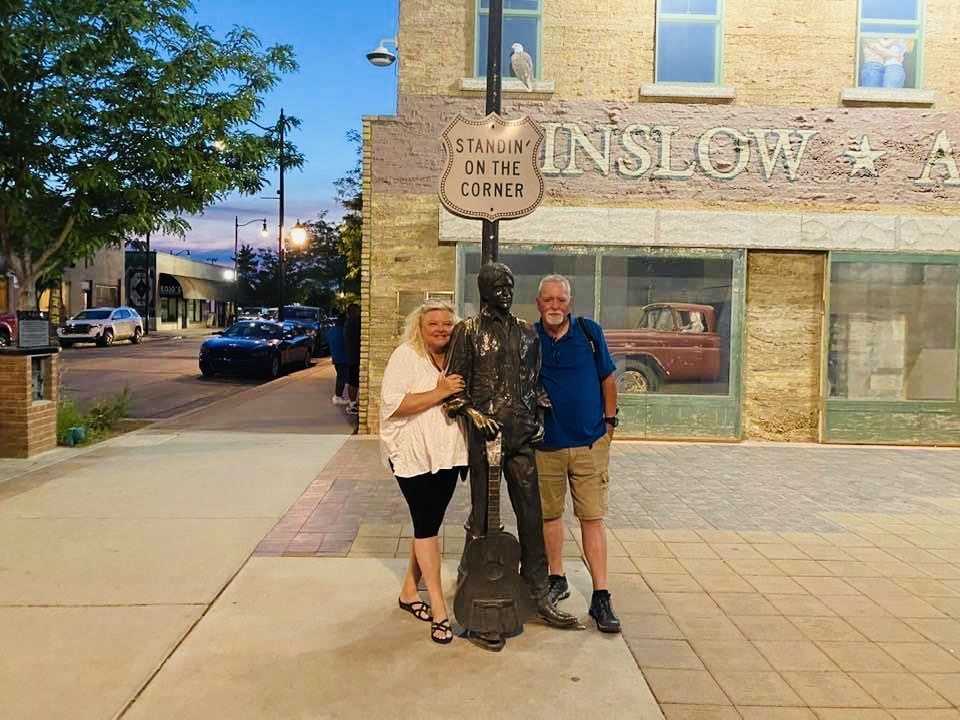
Day Nine: June 24. Winslow to Kingman, Arizona. Another blistering hot day with temperatures reaching 112 degrees. As we neared the Arizona-California border, it was clear the weather would be unforgiving. Midway between Winslow and Kingman, we left Route 66 for a six-mile drive to Meteor Crater, a 550-foot-deep hole in the Earth’s surface created when a gigantic meteor traveling at 26,000 miles per hour slammed into the Earth approximately 500 million years ago. As the best-preserved impact site in North America, visitors are presented with the opportunity to walk the crater’s rugged rim. Enroute to Flagstaff, at one point while traveling on Interstate 40, we caught site of the southern rim of the Grand Canyon. Rolling into Kingman during late afternoon, we registered at El Trovatore Motel, one of the few, pre-World War Two motels erected along the Mother Road still which continues to offer overnight lodging to travelers. According to our guidebook, among the motel’s many guests, Hollywood celebrities Clark Gable, Marilyn Monroe, and James Dean stayed at least one night at this unique destination. Now, the motel can add Holly and myself to its list of celebrated visitors.
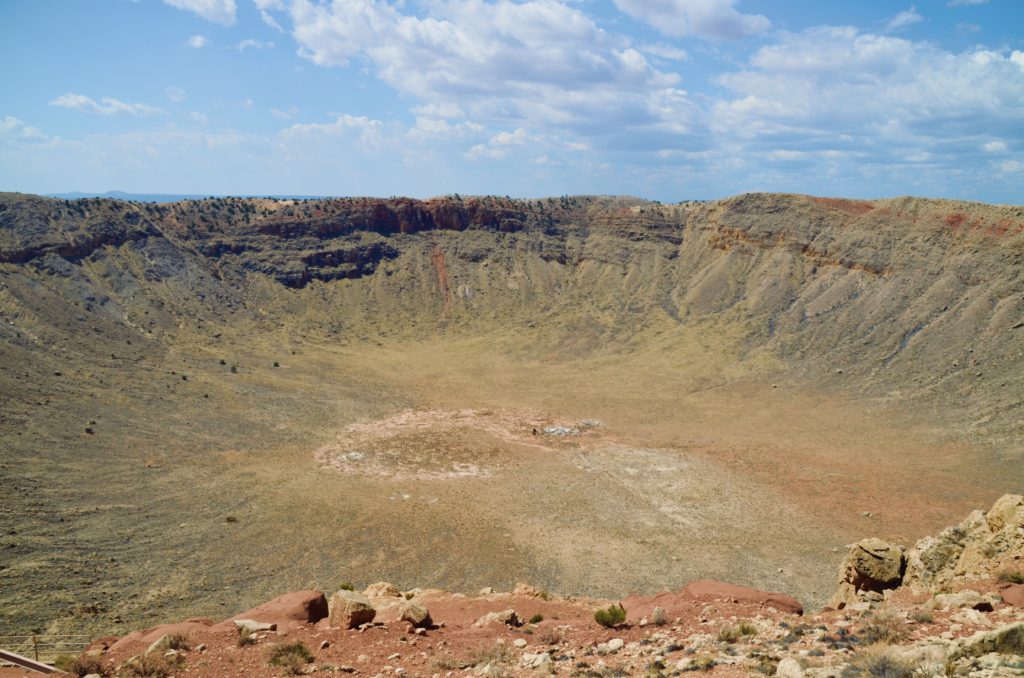
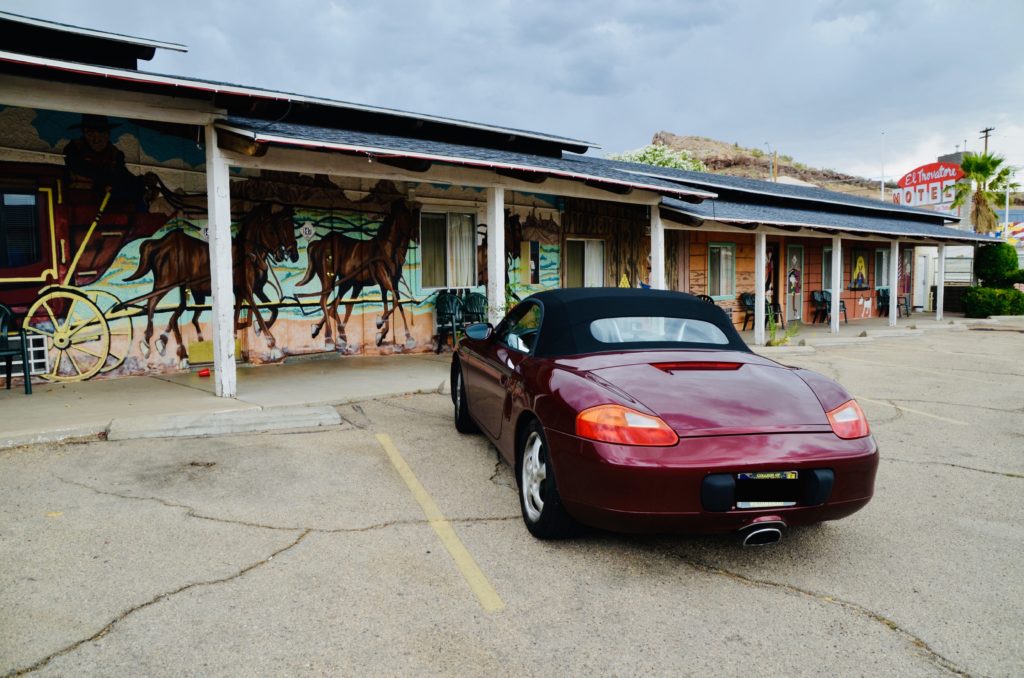
Day Ten: June 25. Kingman, Arizona, to Barstow, California. If you choose to travel the Mother Road in either direction, make a point of dining at Mr. D’z Route 66 Diner before leaving Winslow. You’ll find vintage vinyl covered booths and bar stools, fading posters and photos, and most importantly, excellent food. Erected in 1939 specifically to serve Route 66 travelers, the diner offers plates overfilled with high quality food at a good price as well as an opportunity to step back in time and share a meal with Route 66’s distinguished past. It was here we decided to detour away from Route 66 due to the route ahead becoming exceptionally vertical as well as including a series of severe switchbacks which I did not have the desire to expose the Porsche to. Instead, Holly and I drove to Oatman, Arizona, via I-40 before reconnecting with Route 66 for the twenty-mile journey over a winding and twisting, two-lane road bordered by fields of cacti.
Legend has it Oatman was named after seven-year old Olive Oatman who’d been kidnapped in 1845 by members of the Apache tribe. Drive slow as you enter Oatman: Wild burros roam the streets. According to several sources, the burros are the descendants of those used by gold miners during the 1850s. Somewhat tame, the burros make a point of roaming unmolested through the streets while accepting treats from tourists.
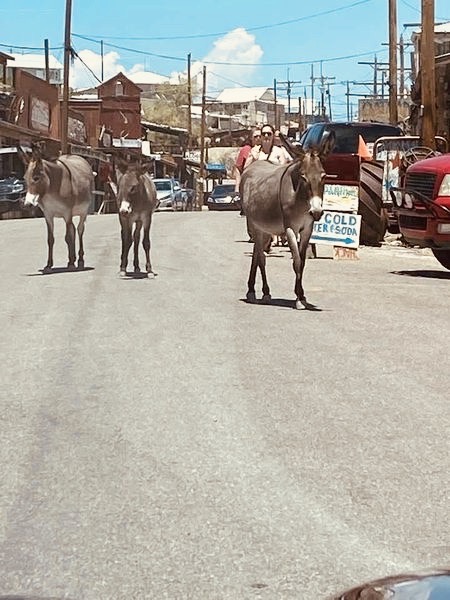
Leaving Oatman and back on I-40 again, we followed the advice of our guidebook and made sure to gas up at the Arizona-California state line before crossing the Mojave Desert. The importance of having a full tank of fuel and at least one gallon of water per passenger cannot be overstated when crossing the desert. With the temperature holding steady at 114 degrees, we followed the guidebook’s advice and took no chances. Be prepared to pay a high cost for a gallon of fuel: filling stations and convenience stores on either end of the desert have no reservations when it comes to charging an exorbitant price for a gallon of gas. The journey across the desert provided Holly and I with sweeping vistas of high mountains, picturesque cliffs and mesas, and wide, barren fields covered with Joshua Trees. Another word of caution: We also noted several broken-down autos alongside the highway, a testament to the environment and it’s unforgiving nature.
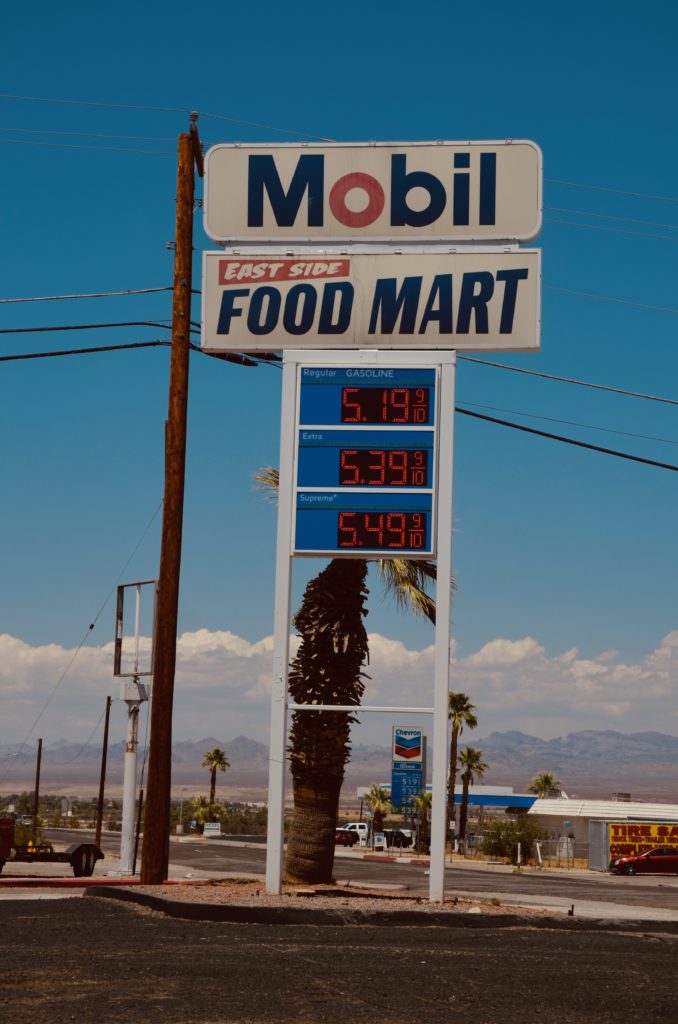
Day Eleven: June 26. Barstow to Santa Monica Pier. Another relatively short day of driving. Or so I believed. Before reaching Santa Monica and Los Angeles, we made a brief stop at the Bottle Tree Ranch to take in the view of a sculpture consisting of thousands of soda bottle, old auto parts, discarded signs and pieces of machinery. With the heat rising, we were off again, eager to arrive in Santa Monica.
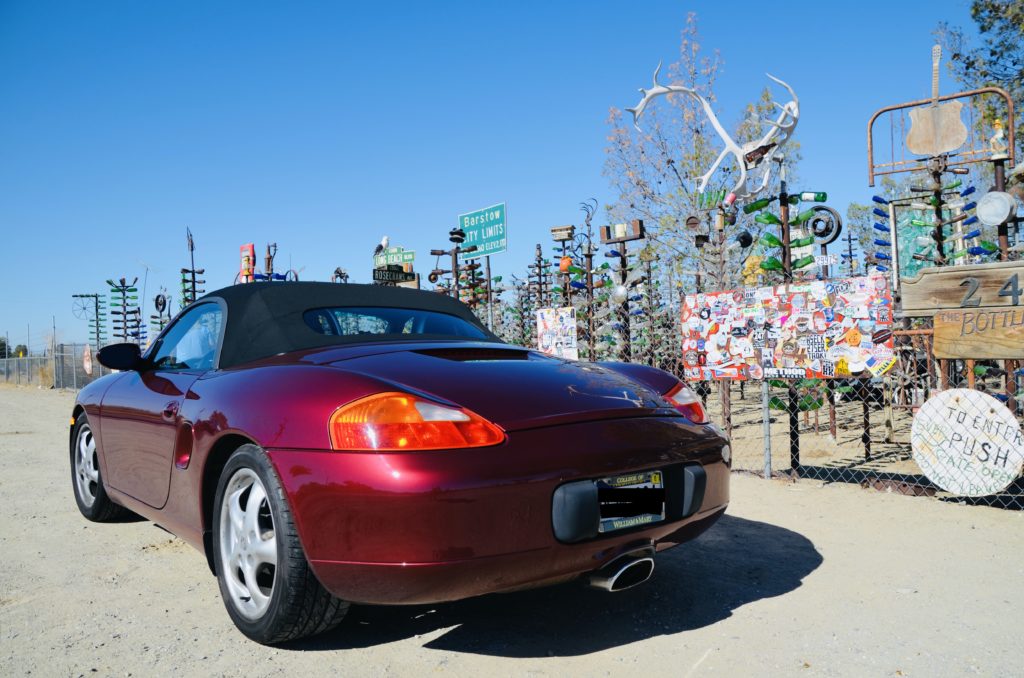
Anyone who has had the “pleasure” of driving through Los Angeles at any hour of any day knows trying to navigate through this sprawling, densely packed city can be something of a challenge. We reconnected with Route 66 ten miles outside Los Angeles and let me just say this: I will never again complain about the traffic in Omaha where driving a distance of no more than five miles requires very little time. Not so in Los Angeles. Expect to spend at least an hour or more in your car if you decide to drive the same distance across Los Angeles.
But, we were there: We’d reached the end of the road. The only task awaiting Holly and myself was to make our way to the pier to the Route 66 kiosk. This proved easy and we snapped several selfies to celebrate the achievement. We also made a point of purchasing a “We Did It!” certificate to celebrate the event.
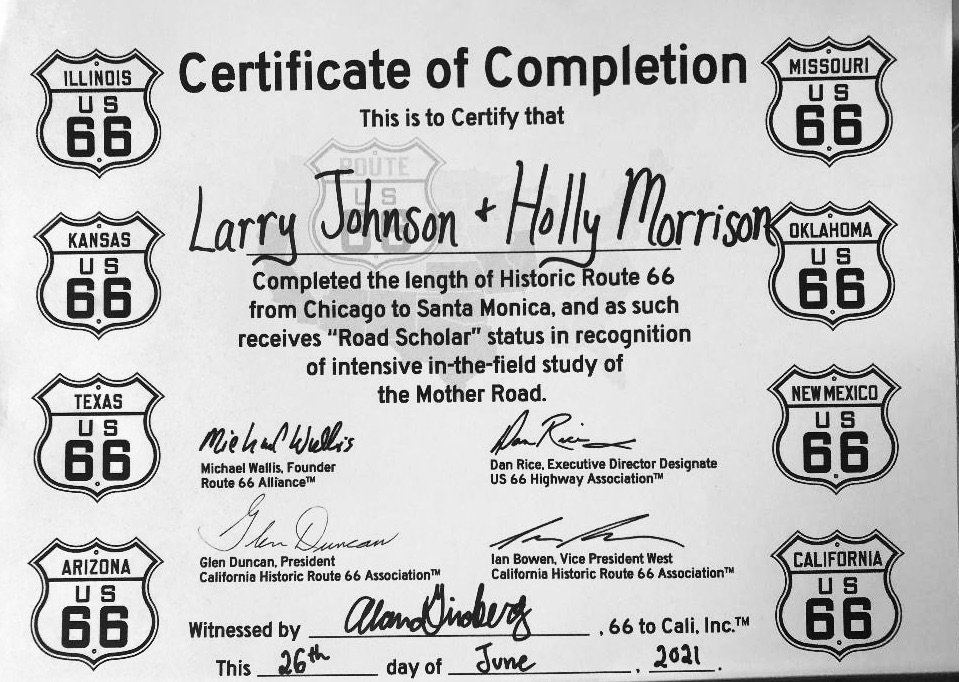
And so, except for the four-day return journey, the trip was over. We left Los Angeles the next morning, heading east through California, Nevada, Utah and Colorado and finally into Nebraska. Our journey came to an end on June 30 after two weeks and 4,000 miles. Waiting for me was the pleasant task of sorting the many photos and videos taken on the trip.
If You Go. My account of traveling along the Mother Road from Omaha to the Pacific coast in a two-seat, convertible-topped vehicle with limited interior space may inspire you to consider taking the same trip. If this is the case, allow me to offer suggestions on what you will need to consider before, during, and after the trek to Santa Monica Pier.
First – and I know this goes without saying – make sure your vehicle is in top operating condition. I performed every preventative maintenance task I am capable of doing on my car, but I neglected to consider the catalytic converter. It was fortunate for me the remedy was easy and inexpensive, but we all know the reason for the “check engine” light coming on could have been far more serious and expensive to resolve. And the possibility of finding a qualified Porsche mechanic or dealership is unlikely in the wide opened spaces between the more densely populated cities located along Route 66.
Also, plan your trip well ahead of time. Before our departure, we purchased Route 66-specific guidebooks and a set of maps which focused on the route’s path through each specific state. With space inside the Boxster being limited, there was no room to unfold a large-scale map. In many stretches of the road, Route 66 comes to an end with little or no warning. Without these helpful guides, we might have found ourselves lost or having to retrace our steps. You can purchase the maps and guidebooks on Google or Amazon.
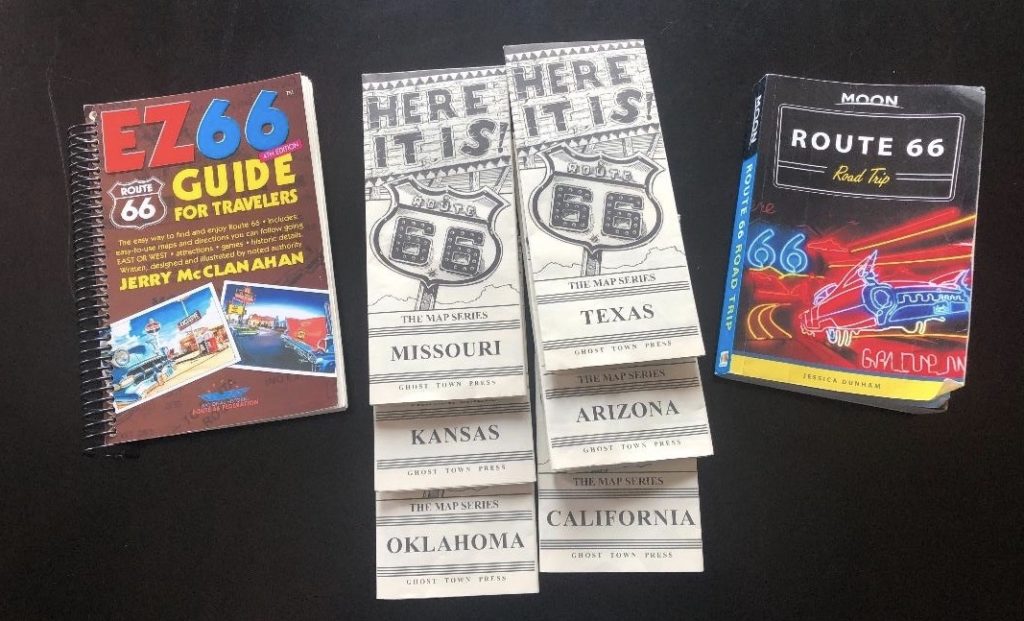
Also, consider taking the trip with someone. Before departing, Holly and I discussed the many wonders we expected to find. Driving to the west coast with my wife not only provided me with a capable copilot but also allowed us to share so many unexpected joys we had no idea existed because they weren’t listed in the guidebooks.
Along with taking the trip with someone, expect to face the possibility of having to decide whether or not to divert off Route 66 for more stable roadways. On more than one occasion, we faced the decision to remain on Route 66 and the possibility of encountering uncertain and possibly hazardous driving conditions, or diverting to an interstate highway. Despite your best intentions, unless you have an unlimited amount of time, it’s impossible to see everything. Only you can make the decision when to remain on the Mother Road or to detour off the route.
Also, despite the road ahead seeming to be smooth and drivable, don’t expect perfectly paved roads. We frequently and unexpectedly encountered deep and potentially dangerous potholes and raised lips on bridges which jolted the car so severely I was certain the front suspension was coming off. In the more rural areas of Route 66, slow down before crossing two-lane bridges: you’ll be glad you did. After being thrown about the Boxster’s interior on several occasions, I decided to remember getting to the west coast as quickly as possible was not one of our priorities. Slow down and enjoy the ride.
Prepare to be shocked by fuel prices. The farther west we drove, especially as we neared the California state line, gas prices rose accordingly. If you’re like me and refuse to fill the fuel tank with low octane fuel, you will quickly come to expect to pay a higher price to fill the vehicle. On the other hand, I don’t recall filling the Boxster with gas which included alcohol or some other unwanted additive. Still, despite this, even I experienced “sticker shock” once we crossed into California where the cost of fuel averaged in excess of four dollars per gallon.
Take a camera. Again, this too goes without saying. As a freelance photographer, I rarely leave home without a camera. For this special, I mounted a small GoPro camera to record the road ahead and another to record the views behind us to provide a different photographic perspective. I also included a digital SLR and each night, downloaded images to an SD card for safekeeping. Ever cautious, I also downloaded the photos and videos to the cloud in the event I misplaced one of the SD cards.
A final word: I cannot say enough about two very important elements which had a direct impact on the success of our journey along America’s most historic road. First, there’s my little car. Except for that uncertain moment outside Santa Fe, the Boxster hummed along like a jewel. I know how fortunate I was in taking a twenty-one year old car along a route which had the potential of offering more negative than positive situations. Over the course of our trip, we covered the same distance as driving from Boston to San Diego, then turning east and returning to Oklahoma City. Yet, we endured nothing out of the ordinary and I feel grateful my car performed at a high level.
Most importantly, however, I need to thank my wife. I’ve mentioned the value of traveling Route 66 with a companion and it’s important to me that I commend Holly for not only making the trip one for the books, but for putting up with me under such cramped and sometimes uncertain conditions. We had the time of our lives and I can’t begin to imagine making this once in a lifetime with anyone else but her.
So, there you have it: my account describing the opportunity to check off another item on my bucket list. I hope you’ve enjoyed reading about our experiences. If you feel the itch to take off on a similar journey over Route 66 and have questions, feel free to contact me at [email protected].
Safe travels, my GPR friends.

